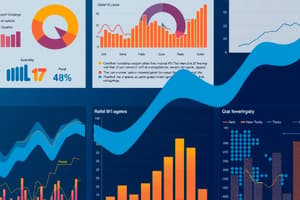Podcast
Questions and Answers
What is a histogram primarily used to illustrate?
What is a histogram primarily used to illustrate?
- The distribution of a single variable (correct)
- The relationship between two variables
- The variability of categorical data
- The central tendency of data
What key statistics are represented in a box plot?
What key statistics are represented in a box plot?
- Mean, mode, and median
- Standard deviation and variance
- Frequency and range
- Minimum, first quartile, median, third quartile, and maximum (correct)
Which plots are used to compare distributions between groups?
Which plots are used to compare distributions between groups?
- Violin plot and density plot (correct)
- Bar chart and line graph
- Pie chart and scatter plot
- Histogram and box plot
What is the primary purpose of a density plot?
What is the primary purpose of a density plot?
How do violin plots differ from box plots?
How do violin plots differ from box plots?
What is the primary goal of data visualization?
What is the primary goal of data visualization?
Which of the following charts is best for showing the relationship between two different variables?
Which of the following charts is best for showing the relationship between two different variables?
What distinguishes a connected scatter chart from a regular scatter chart?
What distinguishes a connected scatter chart from a regular scatter chart?
Which chart type is most suitable for visualizing the most common words in a text?
Which chart type is most suitable for visualizing the most common words in a text?
What does a pie chart primarily represent?
What does a pie chart primarily represent?
Which chart type is best for comparing subgroups within categorical data?
Which chart type is best for comparing subgroups within categorical data?
What is represented by the size of circles in a bubble chart?
What is represented by the size of circles in a bubble chart?
What characteristic does a heatmap provide in data visualization?
What characteristic does a heatmap provide in data visualization?
Which visualization is best for showing hierarchical data?
Which visualization is best for showing hierarchical data?
What is a defining feature of a donut pie chart compared to a regular pie chart?
What is a defining feature of a donut pie chart compared to a regular pie chart?
Flashcards
Histogram
Histogram
A graphical representation of data distribution using bars (bins). It shows the frequency of data within each interval.
Box Plot
Box Plot
A box-and-whisker plot that visually summarizes data distribution using five key statistics: minimum, first quartile, median, third quartile, and maximum.
Violin Plot
Violin Plot
A plot combining elements of a box plot and a kernel density plot to represent data distribution. The shape resembles a violin.
Density Plot
Density Plot
Signup and view all the flashcards
Kernel Density Estimation (KDE)
Kernel Density Estimation (KDE)
Signup and view all the flashcards
Data Visualization
Data Visualization
Signup and view all the flashcards
Asking the Right Questions in Data Visualization
Asking the Right Questions in Data Visualization
Signup and view all the flashcards
Bar Chart
Bar Chart
Signup and view all the flashcards
Scatter Chart
Scatter Chart
Signup and view all the flashcards
Connected Scatter Chart
Connected Scatter Chart
Signup and view all the flashcards
Bubble Chart
Bubble Chart
Signup and view all the flashcards
Wordcloud Chart
Wordcloud Chart
Signup and view all the flashcards
Pie Chart
Pie Chart
Signup and view all the flashcards
Treemap Chart
Treemap Chart
Signup and view all the flashcards
Heatmap
Heatmap
Signup and view all the flashcards
Study Notes
Data Visualization
- Data visualization is the process of displaying data in graphical format, often charts or graphs, to aid understanding and analysis.
- Visualizations improve data comprehension and communication.
- Visualizations enhance interactivity and the ability to convey information effectively to users.
Data Visualization Process
- Data sources are the origin of the information for analysis.
- Ingestion is the process of gathering and importing data.
- Storage involves organizing and preserving the data.
- Processing involves manipulating and organizing the data to prepare for analysis and visualization.
- Analysis and Visualization focuses on gaining insights from the processed data and transforming it into graphical representations.
Questions for Data Visualization Design
- What specific analyses are necessary to gain valuable insights?
- What conclusions can be gleaned from the data?
- Which visualization method best illustrates the insights?
- Should interactive dashboards or reports be generated for user interaction?
Data Visualization Examples
- Bar Charts: Useful for displaying absolute values, suitable for comparing categories or groups (like showing sales figures across different regions).
- Scatter Plots: Demonstrate relationships between two continuous variables visualized by plotted points (plotting student scores on math vs. English to visualize correlations).
- Connected Scatter Plots: Depict the progression of connections to show trends in relationships (a chart demonstrating how customer satisfaction relates to profitability over time).
- Bubble Charts: Useful for showing the relationship between three variables (like illustrating sales figures, product types, and customer location).
- Word Cloud Charts: Highlight prominent words from a text corpus, highlighting important themes (showing keywords related to customer feedback).
Visualizing Aggregate Data
- Pie Charts: Represent portions of a whole, often depicting the percentage or proportion of different categories (illustrating the proportion of customers who prefer different products).
- Donut Pie Charts: A variation of pie charts, with a central empty area, offering a more visually appealing representation.
- Heat Maps: Visually represent data using shades to signify values, highlighting trends in data such as user activity.
- Stacked Column Charts: Ideal for comparing components or subcategories within a category (like showing the composition of different customer segments).
- Tree Maps: Display hierarchical structures through nested rectangles, useful for visualizing part-to-whole relationships, showing hierarchical categories of sales regions).
Visualizing Data Distribution
- Histograms: Illustrating variable distribution, showing the frequency of data within defined ranges (example: the distribution of ages of customers at stores).
- Box Plots: Show data quartiles (minimum, first quartile, median, third quartile, and maximum) helping to identify central tendencies and outliers (highlighting age distribution within customer cohorts).
- Violin Plots: Showcase data distribution with kernel density plots, providing a comprehensive view of data variability.
- Density Plots: Show continuous distributions using smooth curves.
Studying That Suits You
Use AI to generate personalized quizzes and flashcards to suit your learning preferences.




